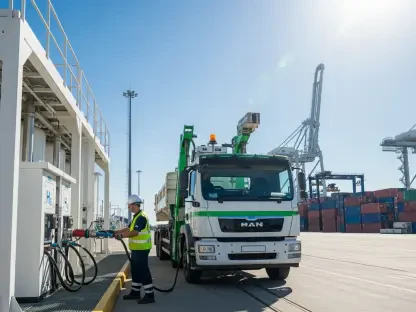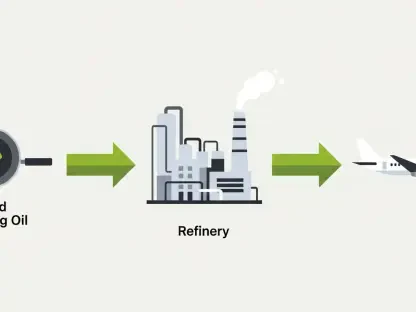The shift towards low-carbon buildings is no longer just an environmental consideration but a pressing economic strategy for real estate stakeholders. Building owners, investors, and occupiers stand on the cusp of a lucrative opportunity with the increasing demand for sustainable spaces driven by corporate and regulatory pressures. By leveraging energy efficiency, electrification, and clean energy sources, significant financial benefits can be realized.
The Market Opportunity for Low-Carbon Buildings
The current market scenario presents an exceptional opportunity for real estate stakeholders to capitalize on the increasing demand for low-carbon buildings. Companies are aligning leased spaces with their emission targets, creating a notable supply gap. This growing imperative to meet sustainability goals has made low-carbon buildings more attractive than ever, opening up avenues for increased market value.
Investors and building owners can benefit immensely by acting quickly to address this demand. A proactive approach is essential to harness the potential for lucrative returns, as the supply of sustainable buildings fails to meet the rapidly growing demand. Immediate investments in low-carbon strategies can help bridge this gap, positioning stakeholders at a strategic advantage. The competitive landscape is swiftly evolving; those who delay risk losing out to early adopters who are already reaping the rewards of lower operational costs and increased occupancy rates linked to sustainable properties.
Key Action Areas for Decarbonization
To successfully decarbonize, real estate stakeholders must focus on three main pillars: energy efficiency, electrification, and integrating clean energy sources. These three areas combine to reduce operational costs, enhance energy security, and comply with evolving regulations.
Energy efficiency measures such as optimizing building operations can significantly cut energy consumption. Electrification, especially transitioning heating and cooling systems to electric power, minimizes reliance on fossil fuels. Lastly, adopting renewable energy sources like solar and wind ensures regulatory resilience and long-term cost savings. Investing in these areas is critical for long-term sustainability and profitability. The integration of these pillars not only helps meet regulatory requirements but also aligns properties with future market demands, providing a robust foundation for continued economic success.
Economic Benefits of Energy Efficiency
Energy efficiency is the quickest route to cost reduction and emission cuts. Implementing energy-efficient upgrades can result in substantial savings, with potential reductions in operational expenses ranging from 10% to 40%. For stakeholders, this translates into billions saved annually in energy costs.
Moreover, efficient buildings are less vulnerable to energy price volatility and infrastructure issues. Investments in energy efficiency lead to enhanced building performance, making properties more attractive to potential tenants. This not only boosts occupancy rates but also sustains higher rental incomes, driving long-term financial benefits. The return on investment is significant, as energy-efficient buildings tend to command premium rents and longer lease terms due to their lower operating costs and improved comfort levels for occupants.
The Advantages of Electrification
Electrification, particularly through the use of heat pumps, provides significant efficiency gains and emission reductions. Transitioning to electric-powered systems for heating and cooling is essential, particularly as regions increasingly mandate all-electric construction.
Cities such as Seattle and Washington, D.C. are already witnessing a substantial share of fully electrified buildings. For building owners, adapting to this shift not only aligns with regulatory requirements but also enhances energy efficiency, driving down costs and increasing property value. The movement towards electrification is gaining momentum, offering substantial opportunities for reducing carbon footprints while tapping into cleaner, more reliable energy sources.
Clean Energy Integration
Incorporating renewable energy sources like solar panels and wind power into building operations provides significant cost benefits. Renewable energy is now one of the cheapest forms of electricity, offering cost savings and sustainable energy security.
Strategies like Virtual Power Purchase Agreements (VPPAs) are crucial where on-site renewable installations may not be feasible. Such agreements enable building owners to secure clean energy, ensuring compliance with regulations and managing energy costs effectively. This integration is pivotal for maintaining competitiveness and achieving sustainability targets. By tapping into renewable energy, properties can achieve energy independence and shield themselves from the uncertainties of fluctuating conventional energy prices.
Trends in Demand for Sustainable Spaces
There is a marked trend among organizations towards occupying spaces that meet sustainability targets. The demand for such spaces is expected to rise, making it imperative for building owners to act swiftly in addressing the supply gap.
Inaction poses significant risks, with existing buildings potentially losing value if they fail to comply with future emission standards. Thus, investing in low-carbon solutions not only helps meet tenant demands but also safeguards asset value. Early adopters of sustainable practices will find themselves at a distinct market advantage. Companies with strong sustainability credentials are more likely to attract eco-conscious tenants willing to pay a premium for green spaces, leading to enhanced property desirability and financial performance.
Regulatory Landscape and Risk Management
The regulatory environment is becoming increasingly stringent, with new policies requiring substantial reductions in energy use and penalizing non-compliance. Cities like New York, Boston, and Seattle have already implemented standards that will affect the majority of existing buildings by 2030.
Building owners must navigate this regulatory landscape by adopting low-carbon practices to avoid penalties and ensure long-term viability. Early investments in compliance measures can mitigate risks associated with stricter future regulations. Proactive engagement with regulatory standards fosters resilience and positions properties favorably in the market. Moreover, compliance with these regulations will likely be a key selling point for future tenants and investors who prioritize sustainability in their decision-making processes.
Energy Use and Emission Disparities
Data analysis reveals significant disparities in energy use and emissions across global cities. Buildings in cities with cleaner energy grids, such as Seattle, have lower emissions compared to those reliant on fossil fuels.
Interestingly, new buildings, despite being more efficient, do not always achieve substantial reductions in overall energy use. This underscores the importance of adopting comprehensive low-carbon strategies beyond just new constructions. Strategies must encompass both new and existing buildings to achieve meaningful emission reductions. Addressing these disparities is crucial for uniform progress towards decarbonization and ensuring that all properties contribute to overall sustainability goals in their regions.
Addressing Stranded Asset Risks
The transition to low-carbon buildings has evolved from being just an environmental ambition to an essential economic strategy for stakeholders in the real estate sector. Building owners, investors, and tenants now find themselves at a pivotal moment where the demand for sustainable spaces is rapidly increasing. This surge is largely driven by corporate goals for sustainability and tightening regulatory pressures aimed at reducing carbon footprints.
For real estate professionals, this growing emphasis on green buildings holds considerable economic potential. By focusing on energy efficiency, building electrification, and sourcing clean energy, these stakeholders can unlock substantial financial advantages. Energy-efficient buildings not only lower operating costs but also enhance property value and attract premium tenants willing to pay more for sustainable living and working environments.
Electrification and the adoption of renewable energy sources further contribute to cost savings and resilience against fluctuating fossil fuel prices. Additionally, buildings that meet stringent environmental standards often qualify for tax incentives and rebates, adding another layer of financial gain. Market demand is increasingly favoring properties that incorporate green technologies, making them more competitive in the marketplace.
Therefore, embracing low-carbon strategies isn’t just an environmental necessity; it is a compelling business case that can lead to significant economic rewards. Real estate stakeholders who recognize and act on this trend will find themselves better positioned to capitalize on the growing market for sustainable buildings.









